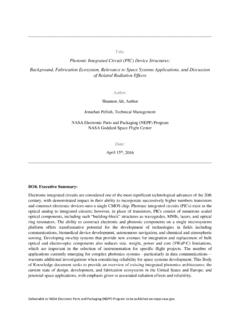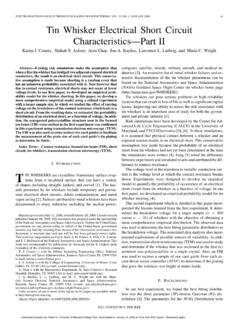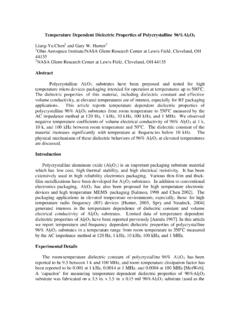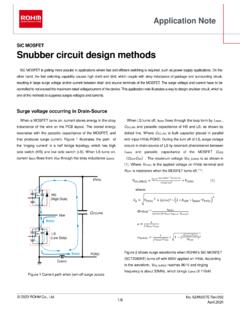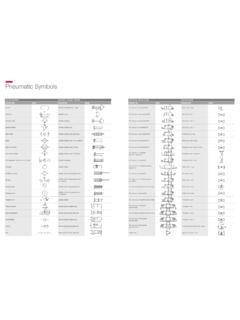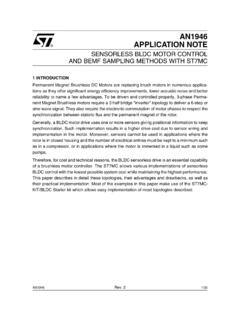Transcription of EEE-INST-002: Instructions for EEE Parts Selection ...
1 NASA/TP 2003 212242 EEE-INST-002: Instructions for EEE Parts Selection , Screening, Qualification, and Derating Prepared by: Dr. Kusum Sahu Reviewed by: Dr. Henning Leidecker Approved by: Darryl LakinsApril 2008, Incorporated Addendum 1 National Aeronautics and Space Administration Goddard Space Flight Center Greenbelt, Maryland 20771 May 2003 ENCLOSURE 1: Addendum 1 for GSFC EEE-INST-002 Connector Section C2, General Section, added new paragraphs 5), 6), and 7) on Page 2. 5) Prohibited connectors. The following connectors are prohibited for Level 1 and Level 2 applications. The following connectors are not recommended for Level 3 applications. The screening and qualification tables that follow do not apply to connectors listed as prohibited. a. CompactPCI connectors and Hard Metric connectors, as well as other connector designs ( Eurocard, VME) with flat bifurcated tuning fork type female contacts.
2 B. Other connector contact systems having two (2) points of contact engagement, or less, that do not utilize a military style hood clamping mechanism to support female contact engagement tines. c. Connectors with compliant pin press fit terminations to flight boards. d. MIL-DTL-55302/ 131 through 134 Eurocard type PWB connectors e. MIL-DTL-55302/ 157 & 158 VME type PWB connectors f. All MIL-C-28754 & MIL-A-28859 modular connectors and assemblies g. All MIL-DTL-32234 blade and fork connectors h. All DSCC drawing high density blade and fork connectors 6) Connectors used in Level 1 and Level 2 space flight applications shall employ an approved, high reliability contact system such as those approved by the NPSL. Examples may include connectors with a hood clamping mechanism surrounding the female contact engagement tines such as those typically used with circular military socket contacts or the reverse gender bulged wire twist pin used with microminiature (Micro-D) style connectors.
3 Connectors used in Level 3 applications should also employ similar contact systems as those approved for Levels 1 and 2. Other contact systems shall be reviewed with the project Parts engineer and Parts control board prior to use. 7) When CompactPCI architecture is desired for flight applications, connectors shall be procured to the NASA GSFC S-311-P-822 specification, from a source of supply specified on the GSFC QPLD. Connector Section C2, Table 1A, Notes, add new note The listing of a military or NASA specification in this table does not imply that all variants of this detail drawing or specification are acceptable for use in flight applications. The requirements of this table do not apply to prohibited connectors. Please refer to the General section for connectors, note 5). Connector Section C2, Table 1B, Notes, add new note The listing of a military or NASA specification in this table does not imply that all variants of this detail drawing or specification are acceptable for use in flight applications.
4 The requirements of this table do not apply to prohibited contacts. Refer to the General section for connectors, note 5). Originator: Terry King, QSS Group, 7 April 2008 Approved: Kusum Sahu, Code 562, 7 April 2008 The NASA STI Program Office .. in Profile Since its founding, NASA has been dedicated to the advancement of aeronautics and space science. The NASA Scientific and Technical Information (STI) Program Office plays a key part in helping NASA maintain this important role. The NASA STI Program Office is operated by Langley Research Center, the lead center for NASA s scientific and technical information. The NASA STI Program Office provides access to the NASA STI Database, the largest collection of aeronautical and space science STI in the world. The Program Office is also NASA s institutional mechanism for disseminating the results of its research and development activities.
5 These results are published by NASA in the NASA STI Report Series, which includes the following report types: TECHNICAL PUBLICATION. Reports of completed research or a major significant phase of research that present the results of NASA programs and include extensive data or theoretical analysis. Includes compilations of significant scientific and technical data and information deemed to be of continuing reference value. NASA s counterpart of peer-reviewed formal professional papers but has less stringent limitations on manuscript length and extent of graphic presentations. TECHNICAL MEMORANDUM. Scientific and technical findings that are preliminary or of specialized interest, , quick release reports, working papers, and bibliographies that contain minimal annotation. Does not contain extensive analysis. CONTRACTOR REPORT. Scientific and technical findings by NASA-sponsored contractors and grantees.
6 CONFERENCE PUBLICATION. Collected papers from scientific and technical conferences, symposia, seminars, or other meetings sponsored or cosponsored by NASA. SPECIAL PUBLICATION. Scientific, technical, or historical information from NASA programs, projects, and mission, often concerned with subjects having substantial public interest. TECHNICAL TRANSLATION. English- language translations of foreign scientific and technical material pertinent to NASA s mission. Specialized services that complement the STI Program Office s diverse offerings include creating custom thesauri, building customized databases, organizing and publishing research results . even providing videos. For more information about the NASA STI Program Office, see the following: Access the NASA STI Program Home Page at E-mail your question via the Internet to Fax your question to the NASA Access Help Desk at (301) 621-0134 Telephone the NASA Access Help Desk at (301) 621-0390 Write to: NASA Access Help Desk NASA Center for AeroSpace Information 7121 Standard Drive Hanover, MD 21076 1320 NASA/TP 2003 212242 EEE-INST-002: Instructions for EEE Parts Selection , Screening, Qualification, and Derating Prepared by: Dr.
7 Kusum Sahu, Goddard Space Flight Center, Greenbelt, MD Reviewed by: Dr. Henning Leidecker, Goddard Space Flight Center, Greenbelt, MD Approved by: Darryl Lakins, Goddard Space Flight Center, Greenbelt, MD National Aeronautics and Space Administration Goddard Space Flight Center Greenbelt, Maryland 20771 May 2003 SECTION 1: PURPOSE, SCOPE, AND GENERAL Instructions APPLICABLE TO ALL EEE PART CATEGORIES THIS PAGE INTENTIONALLY LEFT BLANK Section 1 EEE-INST-002 Instructions for All Part Categories Page 1 of 12 5/03 This section provides a description of the purpose of this document, its scope, and general Instructions that apply to each of the 18 electrical, electronic, and electromechanical (EEE) part categories that are covered in this document. An electronic copy of this document can be downloaded from The electronic copy provides a direct link to the military/industry specifications and standard test methods listed in each section.
8 However, users shall independently verify that the specifications and Test Methods are the latest revisions issued by the responsible authority. Due to the dynamic nature of this document, users are advised to check the website prior to every usage to obtain the latest document revision. PURPOSE The purpose of this document is to establish baseline criteria for Selection , screening, qualification, and derating of EEE Parts for use on NASA GSFC space flight projects. This document shall provide a mechanism to assure that appropriate Parts are used in the fabrication of space hardware that will meet mission reliability objectives within budget constraints. All acronyms used in this document are listed in the acronym table at the end of this section on page11. SCOPE This document provides Instructions for meeting three reliability levels of EEE Parts requirements (see ) based on mission needs.
9 The terms grade and level are considered synonymous; , a grade 1 part is consistent with reliability level 1. Levels of part reliability confidence decrease by reliability level, with level 1 being the highest reliability and level 3 the lowest. A reliability level 1 part has the highest level of manufacturing control and testing per military or DSCC specifications. Level 2 Parts have reduced manufacturing control and testing. Level 3 Parts have no guaranteed reliability controls in the manufacturing process and no standardized testing requirements. The reliability of level 3 Parts can vary significantly with each manufacturer, part type and LDC due to unreported and frequent changes in design, construction and materials. GSFC projects and contractors shall incorporate this guideline into their Project EEE Parts Program. DEFINITIONS Screening. Screening tests are intended to remove nonconforming Parts ( Parts with random defects that are likely to result in early failures, known as infant mortality) from an otherwise acceptable lot and thus increase confidence in the reliability of the Parts selected for use.
10 Qualification. Qualification testing consists of mechanical, electrical, and environmental inspections, and is intended to verify that materials, design, performance, and long-term reliability of the part are consistent with the specification and intended application, and to assure that manufacturer processes are consistent from lot to lot. Derating. Derating is the reduction of electrical and thermal stresses applied to a part during normal operation in order to decrease the degradation rate and prolong its expected life. Source Control Drawing (SCD) - Provides an engineering description (including configuration, part number, marking, reliability, environmental, functional / performance characteristics), qualification requirements and acceptance criteria for commercial items or vendor developed items procurable from a specialized segment of industry that provides for application critical or unique characteristics.
